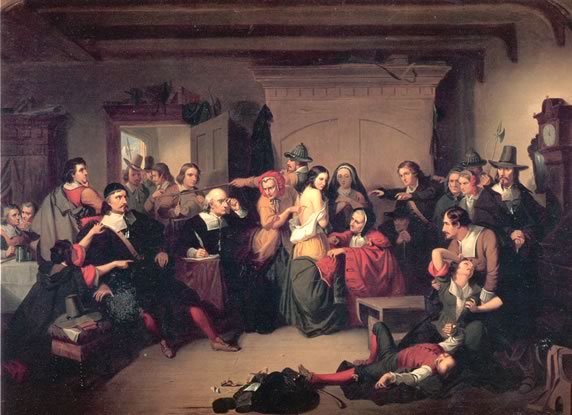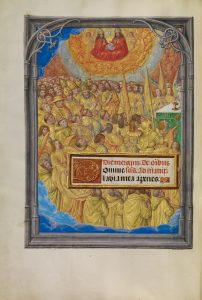Why would adults in Salem, Massachusetts in the 1690s take the accusations of nine year old girls seriously? During the seventeenth century, New England had grown diverse. The people living in the communities were of different backgrounds. But in the 1690’s there was an apparent outbreak of witchcraft. The most famous of these outbreaks was the event in Salem, Massachusetts in 1692 that stirred up the Salem community and soon spread to other communities.
The widespread hysteria over witches was all over the town after an accusation of witchcraft was made in January 1692. A group of young adolescent girls met in the home of Samuel Parris, a Puritan pastor in Salem. The pastor had a nine year old daughter, Betty. Betty and her cousin Abigail were fascinated by the voodoo tales and tricks told to them by the family slave. The family slave, Tituba, was the one whom the little girls had sought after for entertainment.1 It was not long after their time spent with Tituba, when the girls began to behave strangely; seeing visions, babbling at times, and lapsing into trances. The Puritans thought that these behaviors were of witchcraft, as the work of the devil. People in Salem began believing the girls, and charged Tituba and two other village women for practicing witchcraft on them. Two men, John Hathorne and Johnathan Corwin of Massachusetts, were called to do a legal examination of the women. The Puritans followed the Old Testament law. This was how they assessed the examinations. Scripture had a statement that said witches were not able to live. The two men knew exactly what they had to do. The examination was done on these women of Salem by looking for a certain mark on the body: a wart or tit. This specific mark was said to be the place where the devil and his demons would take blood out of the witch.2 Many of the women accused were of lower status in the community.

Research shows most of the accused witches were middle-aged women, widowed, with few or no children. Also, if the woman had been involved with domestic conflicts, they were accused. The women were accused of crimes and appeared to be dangerous by their neighbors. Women in Salem who inherited or possessed land were also accused of witchcraft.3 The accusations towards these women were out of the ordinary and seemingly wrong. One must first think about the view of women during this time. They were undermined and portrayed as having no power or knowledge of such things; they were subservient to the men in the community. Not only were low class women accused of witchcraft, but as time passed, superior women were accused as well.4
On October 29th, the Salem Witch Trials were called to an end. Governor Phips dismissed the Court and that marked the end to the witch hunt craze. Many were disappointed about the ending of the trials, but many were glad to return to work.5 The community in Salem blamed Pastor Parris for letting the innocent die. The people of the Salem church also voted to void his salary. In the following years, those family members of the deceased were restored their good names. The families were awarded a compensation for all the financial loses they went through during such tragic times. Increase Mather, a pastor of the Boston Puritan Church, wanted the people to do away with the court because he believed they put innocent people to death.
The Witch trials took on an important role in American History. The trials became a tragic and memorable moment in history. Generational, racial, and sexual hostility, opposition to law, social stresses, and food poisoning were all causes as to why the people had anxieties that found release in the witch hunt craze. The witch hunts became searches for scapegoats; the community leaders were looking for anyway possible to ease the community’s anxieties.6
- Kenneth P. Minkema, “In the Devil’s Snare: The Salem Witchcraft Crisis of 1692,” The Christian Century, no. 8 (2003): 37. ↵
- Salem Press Encyclopedia, January 2015, s.v. “Salem Witchcraft Trials,” by Warren M. Billings and Kimberly Manning. ↵
- Alan Brinkley, American History, 15th ed., vol. 1: to 1865 (2 Penn Plaza, New York, NY 10121: McGraw Hill Education, 2015), 86-87. ↵
- Salem Press Encyclopedia, January 2015 s.v. “Salem Witchcraft Trials,” by Warren M. Billings, Kimberly Manning. ↵
- Salem Press Encyclopedia, January 2015 s.v. “Salem Witchcraft Trials,” by Warren M. Billings, Kimberly Manning. ↵
- Salem Press Encyclopedia, January 2015 s.v. “Salem Witchcraft Trials,” by Warren M. Billings and Kimberly Manning. ↵



178 comments
Evian-loren Salgado
I knew of the Salem witch trials because I studied it in middle school, however we never went to the depth I feel like this article did. I was unaware of the families of the victims have their reputations restored and receiving money to compensate for their loss. This was a very interesting article with a very catching title. The article was very well written.
Sofia
I learnt in school about Salem trials reading the play write. It is very scary how anyone could be condemned for witchcraft just for been accused by someone else. It could be for something as simple as trying to learn how to read or something out of the regular activities. Or you could be accused by someone else just because they don’t like you. That fear to knowledge limited the society and didn’t allow for it to grow and develop for centuries.
Tyler Thompson
After reading about the Salem Witch Trials in my history class in High School, I was always interested to learn a little more, it was a horrible thing that they would do to women, and little girls. If they were to accuse someone of being a witch and they were wrong, which was all the time, they were taking the innocent lives of others. Fortunately, that period has ended, but it must have been a terrible experience.
Natalie Childs
The title of this article is really what drew me in. It connected Salem with a more common idea of witchcraft: hocus pocus. I have pretty good knowledge of this time period due to a similar article, so I am always interested in reading others perspectives on the time. This time period really shows just how much the lack of understanding of things can cause something so terrible to happen.
Cherice Leach
This story of the witches of Salem is absurd. I understand the children started to act strange but I don’t believe they should have sought out the slave Tituba and they should have looked upon the young girls. I truly believe Increase Mather is completely right when he says innocent people were killed. I also agree with the fact that people were finding scapegoats to try and make society right through their eyes but who gave them the power to decide who should live and who should die?
Aaiyanna Johnson
The title caught my attention immediately. I enjoyed the article. I personally believe that they persecuted those women as an excuse to kill them. The characteristics of witch craft were very similar to that of voodoo, which was practiced by many slaves, and they could not explain it, so they exhorted to murder. It was truly unfortunate, but people today are still persecuting that which they do not understand…
Clarissa Bustamante
Great article! I remember learning about the Salem witch trials but I do not recall hearing about how the families were reimbursed following the trials. Also it is very interesting how there was a marking for the demons or devil as being in the form of a tick or wart. It is hard to believe that people were constantly accused of witch craft and especially women.
Mariet Loredo
Great article. I studied the Salem Witch Trials in high school. We watched a great movie telling the story of how everything started, called The Crucible. It is strange that they believed 9 year old girls accusing older women that they were witches. If a 9 year old would of came up to me and accused someone that they were a witch I would have a really hard time believing it. To be honest, I would have a hard time believing anyone if they came up to me saying that. I wouldn’t believe it until I had seen it with my own two eyes.
Mariah Cavanaugh
I was drawn in by your question. Why would a town full of people believe 2 young girls? I have also always wondered why they jumped right to witchcraft as opposed to asking themselves what else could cause these symptoms. You answer that question in your article. They used these deaths as a way to eliminate the communities anxieties. It really isn’t a stretch to imagine the same thing happening in today’s society. Your article was informative and addressed things that were not well know, such as the fact that the families of the accused were reimbursed. Great job!
Crystalrose Quintero
I really can appreciate that the first paragraph poses a question that is to be answered. Another way of intimating a topic sentence. It was also very interesting to read that something like a birth mark or mole would at that time be taken into something that could potentially be the cause of supernatural or sorcery things. It was sad to read that the conclusion said what was implied which was that the witch hunt began taking innocent people so as to relieve the community of their worries.